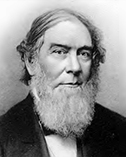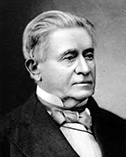
 Alexander Dallas Bache
Alexander Dallas Bache
1863-1867 NAS President
The Academy started with fifty charter members under the presidency of Alexander Dallas Bache (1806–1867). The number was not increased during the remaining years of the war because a generally acceptable means for electing them had not yet been developed. Bache was a great-grandson of Benjamin Franklin, an outstanding West Point trained physical scientist and engineer as well as an expert in numerous other fields. He had been born and raised in Philadelphia and always looked on that community as his home base.
An individual of quiet demeanor, Bache was a very serious student at West Point and graduated first in his class. He was greatly admired by a group of colleagues who took the time and effort to shield him from occasional sportive distractions in which they might engage. On graduation in 1825, he continued at West Point as an assistant professor for a year. This was followed by two years of engineering duty in Rhode Island, which was followed in turn by an appointment to the chair of physics and chemistry at the University of Pennsylvania. He also accepted a position at the newly created Franklin Institute, which gave him an opportunity to investigate important technical problems, such as the frequent explosion of steam boilers. In addition, he became interested in fluctuations in the earth's magnetic field and made measurements of it. He also studied the relative thermal effects of various parts of the visible and invisible portions of the optical spectrum derived from the sun.
In 1836 the trustees of the newly created Girard College for Orphans in Philadelphia offered him the position of president, which he accepted reluctantly out of a sense of duty to public service. The offer carried with it a fund that permitted him to make a two-year study of educational practices in Europe, where he was well received everywhere he traveled, partly in memory of his widely famed great-grandfather. On returning he found that the post at Girard College was not yet available because of delays in building construction. As a result he offered to make a study of educational practices in the public school system of Philadelphia, serving as head of the Central High School of Philadelphia. His offer was accepted and led to a substantial modification of the ongoing system in keeping with his European experience. In the meantime, matters continued to lag at Girard College, but the University of Pennsylvania gladly welcomed his return in 1842. He was soon extending research programs he had left behind.
A year or so later he was offered the newly vacant position of Superintendent of the United States Coastal Survey, which he accepted with his usual trepidation when considering a major change. Actually he found his life's mission in the new post and was very successful. He received many auxiliary appointments, some honorific, others in the line of duty. His relations with Congress were excellent although he was occasionally asked: “When will you finish the survey?” His invariable response was: “When you cease annexing territory!”
To accomplish the tasks of the Survey, Bache needed a very competent staff and was fortunate in acquiring some extraordinarily capable individuals. He found one, George Davidson, while working with the Philadelphia educational system. Davidson was the leading student in his high school class and proved to be a very helpful aide in connection with Bache's experiments. He joined the Survey on graduation and, as we shall see later, soon rose to one of the leading positions on the staff.
In his will, Alexander Bache left the sum of $40,000 in trust to the Academy with the understanding that the income would be available to his widow for the remainder of her life and could then be used for the needs of the Academy. This first significant bequest played an important role during the startup peacetime period that followed. By 1895 the accumulation of such trust funds came to $87,000.
 The Smithsonian: Joseph Henry
The Smithsonian: Joseph Henry
At the time the National Academy of Sciences was formed, the most distinguished scientist in the country was Joseph Henry (pictured right), the first director (Secretary) of the Smithsonian Institution in Washington, D.C.—a position to which he had been appointed in 1846. This followed a series of Congressional debates that lasted some ten years following the arrival in Washington in 1836, in the form of gold bullion, the very significant bequest by an Englishman, James Smithson, the illegitimate son of the Duke of Northumberland, that funded the start of the Smithsonian. Smithson's intent was to try to help the young democratic country become as deeply involved in scientific research as possible. When minted into American gold coinage the total bequest from Smithson totaled about $650,000—a very large fortune for those days.
Henry was made a founding member of the Academy, but had not been informed of the detailed plans of the founding committee along the way, presumably either for fear that he would dominate decisions regarding details, or might disapprove of the creation of an academy during wartime. Actually, Henry expressed concern regarding the fact that the newly formed Academy had roots in governmental action, since he feared that it might thereby become politicized. He had reason for his fears since, at the Smithsonian, he had to deal with the membership of a regency that oversaw his activities and was appointed by Congress. The Chief Justice of the United States serves ex officio as a member of the regents and by tradition as chairman (Chancellor). The Vice President also serves ex officio. The membership includes three senators, three representatives from the House and six from the more general public. The latter may include heads of museums, distinguished academics, and other members at large, such as lawyers and businessmen. Service on the board of regents is regarded as a special honor, particularly among individuals close to the District of Columbia. Actually Henry was not only a skilled politician, but he quickly won the deepest respect of the Washington community and had little difficulty personally dealing with the regents. Finally he did agree to be a member of the newly formed academy in spite of the misgivings mentioned above.
Henry (1797–1878) was born in Albany, New York. While growing up he spent time both there and with relatives in the nearby smaller town of Galway, which has commemorated this fact by naming a very handsome elementary school building after him. His advanced education was obtained at the Albany Academy, which continues to be an active institution and which had a year-long celebration of the bicentennial of Henry's birth in 1997. There he developed two great interests: science, particularly physics, and acting on a live stage. He was torn in making a selection between the two when he finally had to decide on a career, but swung to physics when he had an opportunity to experiment with large electromagnets of his own making at the Albany Academy. Incidental to this, he discovered the magnetic induction of electric currents in electric conductors in 1831, a year before Faraday who published the discovery first. Both individuals, however, are fully credited with independent discovery of this phenomenon. The official name assigned to the physical unit of electromagnetic inductance is The Henry. Henry's ability as an actor may have stood him in good stead during the Washington years that were to come.
Henry remained at the Albany Academy until 1832, when he accepted a professorial appointment at what is now Princeton University. There he remained actively creative, particularly in connection with the development of the electromagnetic telegraph, until he was called to Washington to head the Smithsonian.
During the Civil War, Henry spent as much time as possible studying the properties of electrically operated devices that could be used for communication, often working at night in one of the towers of a building of the Institution when he was apt to be relatively free of other obligations. A private citizen noted the flashing lights one evening and rushed into the White House to inform President Lincoln that a spy was using the Institution to signal across the Potomac. The President formed a small detachment of soldiers and rushed to the tower, only to find, and meet for the first time, the great scientist busy doing what he enjoyed most. They became good friends. It is said that Lincoln once made the comment that he believed that Henry was the most intelligent individual he had ever met.
The members of the Academy investigated the problems that came to them during the war as best they could, although nothing truly outstanding in the way of innovation occurred as a result of their activity. This was a period in which most innovation centered about the activities of ingenious inventors who focused on mechanical and early electrical systems, such as steam-powered, ironplated warships, rifled guns and improvements in the telegraph system.
When the Civil War ended in 1865, the members of the National Academy were faced with the problem of determining how it might be used in peacetime. They had models in Europe that could be employed as a guide. However, the latter had not only been established for a relatively long time but along the way had been endowed, usually by royalty and “philosophers of wealth”, with significant resources such as money for running expenses and buildings where meetings could be held and records stored. In real terms, the National Academy of Sciences only possessed a charter and the interest of its founding members.
In the meantime Bache had resigned as president at the end of the war because of rapidly failing health, leaving his office in the hands of the vice president. The latter was also in bad health and in turn gave his office over to Joseph Henry. The most obvious solution was to offer the position of president to Henry who had the capacity to serve in an imaginative manner and provide something in the way of a significant foster home at the Smithsonian. He refused. It was not only that he was approaching his seventieth year, but also continued to enjoy carrying on research, particularly in connection with acoustics. Still further, he had not been greatly enamored of the surreptitious manner in which the Academy had been formed along with its links to the federal government.
Continue reading next chapter: Joseph Henry

